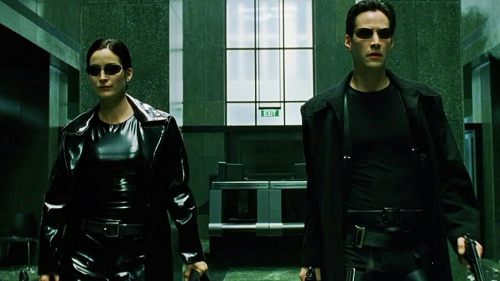Say Something Nice: THE MATRIX REVOLUTIONS (2003)
Lana and Lilly Wachowski's sequels to The Matrix are undoubtedly the low points, creatively speaking, of their careers. Originally intended to be a prequel and a sequel, they represent a story stretched uncomfortably from one to two films, a scattershot bunch of ideas glued together by visual effects that were ahead of their time - and rendering capacity.
But such ideas! Both sequels expand upon the philosophical questions at the heart of The Matrix by exploring the world of the machines as well as that of the humans. Both deliver insane action spectacle, both in the digital world of the Matrix and the real of Zion. And both offer heady answers to the series’ core questions - often in the form of more questions. The Matrix sequels are seriously flawed, but there's far more value in them than the public's sneering dismissal would suggest.
In putting together a Say Something Nice column about these sequels, many sequences came to mind - sequences despised unfairly by audiences, presumably because they didn't just offer more Matrix. Reloaded's Zion rave sequence, often cited inexplicably as the series’ low point, is the moment that film comes alive; in the light of later Wachowski work like Sense8, it's a moment of life-affirming movement and sexuality that gives humanity something to fight for. The infamous Architect lecture, most frequently criticised for its purple language and Colonel Sanders costume choice, is a conscious reframing of the series’ narrative from “chosen one” into “choosing one.” And Revolutions’ lengthy “Limbo” train-station digression is an important step towards granting the machines hopes and dreams of their own.
But the sequels’ finest moment comes at the end of it all. Having traveled to the machines’ central hub, Neo makes a deal with their collective consciousness: he will rid their networks of the rapidly-expanding virus Agent Smith has become, in exchange for cessation of hostilities between machine and humankind. The machines, though reluctant to admit they need help, agree, dropping Neo into the Matrix for the series’ climactic showdown.
Upon arriving in the Matrix, Neo is confronted by a startling sight. Smith's clones everywhere, lining the streets and skyscraper windows alike - a chilling representation of his new viral nature, itself ironic given his description of humanity as such in the first film. But Neo doesn't fight a city full of Smiths. This isn't some escalated retread of Reloaded's already-ridiculous “Burly Brawl.” No, all those Smiths merely spectate The Matrix Revolutions’ final battle: a punch-up between Neo and a single representative Smith that's not only the series’ most dizzying action sequence, but one of the greatest superhero fight scenes in cinema.
Known internally as the Super Burly Brawl, despite its dissimilarities to its precursor, Revolutions’ climactic fight moves effortlessly from close-up kung fu to city-spanning superpowered combat. Its combatants soar and tumble above the Matrix's megacity, each punch creating massive shockwaves that displace even the rain in which the fight takes place. Impacts create craters in the street. Lightning is drawn, elementally, to their bodies. Sometimes the camera moves miles back to depict the fight's epic scale - only to jump back in for slow motion, CGI-enhanced closeups detailing the impact of every punch. The choreography and cinematography is magnificent; one can't help but compare it to the likes of Man of Steel, whose superhero fight failed to muster a fraction of this beautiful, horrific grandeur. The sequence is also anime as fuck, of course, bringing to a climax the series’ obvious adoration for the genre.
But for all its choreographic and visual-effects spectacle, the Super Burly Brawl wouldn't be worth a damn if it didn't mean something. Everyone in the Matrix sequels is looking for purpose - a reason to carry on, a way to be useful - everyone except, seemingly, Smith, who's content merely to expand and multiply and ruin everyone's day. That's part of why Smith can't understand Neo's determination to continue fighting, even in the face of overwhelming odds (and Smiths).
Neo's reasoning to Smith is simple, and it illustrates a defining characteristic of being human: he continues because he chooses to. People aren't bound by logic, or blunt calculations as to the probability of success. We have free will, and we can choose to do things even if they seemingly make no sense. This is the disarmingly simple crux of the Matrix sequels’ existential debate. For this writer - who grapples regularly with depression and its ever-gnawing question of “what's the point?” - Neo's answer to Smith is indeed a revolution. Sometimes there is no point, other than our personal will to continue. That's a frightening reality to face, but if one can muster that will, it's an empowering one. And it is strength of will - greater than any programming or obligation or shrugging inertia - that allows Neo to defeat Smith. It's not about the punching; it's about why we punch.
The upshot of Neo's deal with the machines, and defeat of Smith, is a peace, however uneasy, between humans and machines. That likely sits unhappily with audiences who wanted an ending of destruction and conquest, but the movie's smarter and more humane than that. The Matrix Revolutions ends on a literally sunny note, with humankind and machinekind alike free to exert their own will - to be who they want to be. That's as Wachowski a resolution as you can get, and it's part of why the Matrix sequels deserve a reappraisal.



